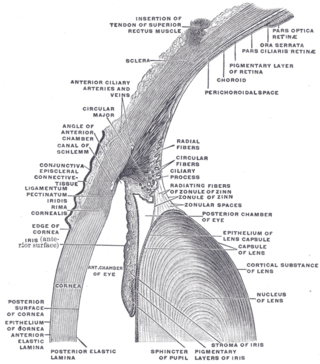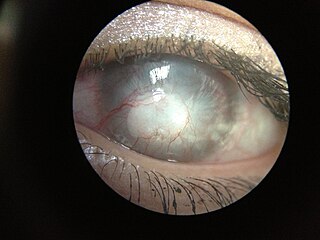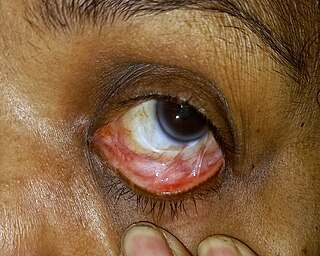Related Research Articles

The cornea is the transparent front part of the eye that covers the iris, pupil, and anterior chamber. Along with the anterior chamber and lens, the cornea refracts light, accounting for approximately two-thirds of the eye's total optical power. In humans, the refractive power of the cornea is approximately 43 dioptres. The cornea can be reshaped by surgical procedures such as LASIK.

A pterygium of the eye is a pinkish, roughly triangular tissue growth of the conjunctiva onto the cornea of the eye. It typically starts on the cornea near the nose. It may slowly grow but rarely grows so large that it covers the pupil and impairs vision. Often both eyes are involved.

In the anatomy of the eye, the conjunctiva is a thin mucous membrane that lines the inside of the eyelids and covers the sclera. It is composed of non-keratinized, stratified squamous epithelium with goblet cells, stratified columnar epithelium and stratified cuboidal epithelium. The conjunctiva is highly vascularised, with many microvessels easily accessible for imaging studies.

A red eye is an eye that appears red due to illness or injury. It is usually injection and prominence of the superficial blood vessels of the conjunctiva, which may be caused by disorders of these or adjacent structures. Conjunctivitis and subconjunctival hemorrhage are two of the less serious but more common causes.
A topical anesthetic is a local anesthetic that is used to numb the surface of a body part. They can be used to numb any area of the skin as well as the front of the eyeball, the inside of the nose, ear or throat, the anus and the genital area. Topical anesthetics are available in creams, ointments, aerosols, sprays, lotions, and jellies. Examples include benzocaine, butamben, dibucaine, lidocaine, oxybuprocaine, pramoxine, proxymetacaine (proparacaine), and tetracaine.

A corneal ulcer, or ulcerative keratitis, is an inflammatory condition of the cornea involving loss of its outer layer. It is very common in dogs and is sometimes seen in cats. In veterinary medicine, the term corneal ulcer is a generic name for any condition involving the loss of the outer layer of the cornea, and as such is used to describe conditions with both inflammatory and traumatic causes.

Vernal keratoconjunctivitis is a recurrent, bilateral, and self-limiting type of conjunctivitis having a periodic seasonal incidence.

Corneal neovascularization (CNV) is the in-growth of new blood vessels from the pericorneal plexus into avascular corneal tissue as a result of oxygen deprivation. Maintaining avascularity of the corneal stroma is an important aspect of healthy corneal physiology as it is required for corneal transparency and optimal vision. A decrease in corneal transparency causes visual acuity deterioration. Corneal tissue is avascular in nature and the presence of vascularization, which can be deep or superficial, is always pathologically related.

Corneal ulcer, also called keratitis, is an inflammatory or, more seriously, infective condition of the cornea involving disruption of its epithelial layer with involvement of the corneal stroma. It is a common condition in humans particularly in the tropics and in farming. In developing countries, children afflicted by vitamin A deficiency are at high risk for corneal ulcer and may become blind in both eyes persisting throughout life. In ophthalmology, a corneal ulcer usually refers to having an infection, while the term corneal abrasion refers more to a scratch injury.

Corneal tattooing is the practice of tattooing the cornea of the human eye. Reasons for this practice include improvement of cosmetic appearance and the improvement of sight. Many different methods and procedures exist today, and there are varying opinions concerning the safety or success of this practice.

A symblepharon is a partial or complete adhesion of the palpebral conjunctiva of the eyelid to the bulbar conjunctiva of the eyeball. It results either from disease or trauma. Cicatricial pemphigoid and, in severe cases, rosacea may cause symblepharon. It is rarely congenital. Its treatment is symblepharectomy.

Conjunctivochalasis, also known as mechanical dry eye (MDE), is a common eye surface condition characterized by the presence of excess folds of the conjunctiva located between the globe of the eye and the eyelid margin.

Herpetic simplex keratitis is a form of keratitis caused by recurrent herpes simplex virus (HSV) infection in the cornea.
Jeewan Singh Titiyal is an Indian ophthalmologist, credited with the first live cornea transplant surgery by an Indian doctor. He was honoured by the Government of India, in 2014, by bestowing on him the Padma Shri, the fourth highest civilian award, for his services to the field of medicine.

Limbal stem cells, also known as corneal epithelial stem cells, are unipotent stem cells located in the basal epithelial layer of the corneal limbus. They form the border between the cornea and the sclera. Characteristics of limbal stem cells include a slow turnover rate, high proliferative potential, clonogenicity, expression of stem cell markers, as well as the ability to regenerate the entire corneal epithelium. Limbal stem cell proliferation has the role of maintaining the cornea; for example, by replacing cells that are lost via tears. Additionally, these cells also prevent the conjunctival epithelial cells from migrating onto the surface of the cornea.
Neurotrophic keratitis (NK) is a degenerative disease of the cornea caused by damage of the trigeminal nerve, which results in impairment of corneal sensitivity, spontaneous corneal epithelium breakdown, poor corneal healing and development of corneal ulceration, melting and perforation. This is because, in addition to the primary sensory role, the nerve also plays a role maintaining the integrity of the cornea by supplying it with trophic factors and regulating tissue metabolism.

Virender Singh Sangwan is an Indian ophthalmologist and the Dr. Paul Dubord Chair professor and director of the L. V. Prasad Eye Institute, Hyderabad. Known for his research on limbal stem cells, Sangwan is the founder secretary and an adviser of the Uveitis Society of India. The Council of Scientific and Industrial Research, the apex agency of the Government of India for scientific research, awarded him the Shanti Swarup Bhatnagar Prize for Science and Technology, one of the highest Indian science awards for his contributions to Medical Sciences in 2006.

Corneal opacification is a term used when the human cornea loses its transparency. The term corneal opacity is used particularly for the loss of transparency of cornea due to scarring. Transparency of the cornea is dependent on the uniform diameter and the regular spacing and arrangement of the collagen fibrils within the stroma. Alterations in the spacing of collagen fibrils in a variety of conditions including corneal edema, scars, and macular corneal dystrophy is clinically manifested as corneal opacity. The term corneal blindness is commonly used to describe blindness due to corneal opacity.
Exposure keratopathy is medical condition affecting the cornea of eyes. It can lead to corneal ulceration and permanent loss of vision due to corneal opacity.
Peripheral Ulcerative Keratitis (PUK) is a group of destructive inflammatory diseases involving the peripheral cornea in human eyes. The symptoms of PUK include pain, redness of the eyeball, photophobia, and decreased vision accompanied by distinctive signs of crescent-shaped damage of the cornea. The causes of this disease are broad, ranging from injuries, contamination of contact lenses, to association with other systemic conditions. PUK is associated with different ocular and systemic diseases. Mooren's ulcer is a common form of PUK. The majority of PUK is mediated by local or systemic immunological processes, which can lead to inflammation and eventually tissue damage. Standard PUK diagnostic test involves reviewing the medical history and a completing physical examinations. Two major treatments are the use of medications such as corticosteroids or other immunosuppressive agents and surgical resection of the conjunctiva. The prognosis of PUK is unclear with one study providing potential complications. PUK is a rare condition with an estimated incidence of 3 per million annually.
References
- 1 2 Zelefsky, Joseph R; Srinivasan, Muthiah; Cunningham, Emmett T (August 2011). "Mooren's ulcer". Expert Review of Ophthalmology. 6 (4): 461–467. doi:10.1586/eop.11.46. ISSN 1746-9899. S2CID 29415711.
- ↑ Dong, Yanling; Zhang, Yangyang; Xie, Lixin; Ren, Jianmei (February 2017). "Risk Factors, Clinical Features, and Treatment Outcomes of Recurrent Mooren Ulcers in China". Cornea. 36 (2): 202–209. doi:10.1097/ico.0000000000001084. ISSN 0277-3740. PMID 28060068. S2CID 13508732.
- 1 2 Srinivasan, M.; Zegans, M. E; Zelefsky, J. R; Kundu, A.; Lietman, T.; Whitcher, J. P; Cunningham, E. T (2006-10-11). "Clinical characteristics of Mooren's ulcer in South India". British Journal of Ophthalmology. 91 (5): 570–575. doi:10.1136/bjo.2006.105452. ISSN 0007-1161. PMC 1954782 . PMID 17035269.
- ↑ Watson, P G (May 1997). "Management of Mooren's ulceration". Eye. 11 (3): 349–356. doi: 10.1038/eye.1997.74 . ISSN 0950-222X. PMID 9373475. S2CID 12163492.
- ↑ Taylor, Craig J.; Smith, Sheila I.; Morgan, Catherine H.; Stephenson, Susan F.; Key, Tim; Srinivasan, M.; Cunningham, Emmett; Watson, Peter G. (2000-01-01). "HLA and Mooren's ulceration". British Journal of Ophthalmology. 84 (1): 72–75. doi:10.1136/bjo.84.1.72. ISSN 0007-1161. PMC 1723219 . PMID 10611103.
- 1 2 Lee, Hyun Ju; Kim, Mee Kum; Wee, Won Ryang; Oh, Joo Youn (September 2015). "Interplay of Immune Cells in Mooren Ulcer". Cornea. 34 (9): 1164–1167. doi:10.1097/ICO.0000000000000471. ISSN 0277-3740. PMID 25970436. S2CID 30578961.
- ↑ Murray, P. I.; Rahi, A. H. (March 1984). "Pathogenesis of Mooren's ulcer: some new concepts". The British Journal of Ophthalmology. 68 (3): 182–187. doi:10.1136/bjo.68.3.182. ISSN 0007-1161. PMC 1040283 . PMID 6230102.
- ↑ Shinomiya, Katsuhiko; Ueta, Mayumi; Sotozono, Chie; Inatomi, Tsutomu; Yokoi, Norihiko; Koizumi, Noriko; Kinoshita, Shigeru (2013-03-01). "Immunohistochemical analysis of inflammatory limbal conjunctiva adjacent to Mooren's ulcer". British Journal of Ophthalmology. 97 (3): 362–366. doi:10.1136/bjophthalmol-2012-302631. ISSN 0007-1161. PMID 23292924. S2CID 7491218.
- 1 2 Kafkala, Chrysanthi; Choi, John; Zafirakis, Panayotis; Baltatzis, Stefanos; Livir-Rallatos, Charalampos; Rojas, Blanca; Foster, C. Stephen (July 2006). "Mooren Ulcer: An Immunopathologic Study". Cornea. 25 (6): 667–673. doi:10.1097/01.ico.0000214216.75496.7e. ISSN 0277-3740. PMID 17077658. S2CID 1948763.
- ↑ Gottsch, John D.; Liu, Sammy H.; Stark, Walter J. (April 1992). "Mooren's Ulcer and Evidence of Stromal Graft Rejection After Penetrating Keratoplasty". American Journal of Ophthalmology. 113 (4): 412–417. doi: 10.1016/s0002-9394(14)76164-1 . ISSN 0002-9394. PMID 1558115.
- ↑ Gottsch, J. D.; Li, Q.; Ashraf, F.; O'Brien, T. P.; Stark, W. J.; Liu, S. H. (1999-04-01). "Cytokine-Induced Calgranulin C Expression in Keratocytes". Clinical Immunology. 91 (1): 34–40. doi: 10.1006/clim.1998.4681 . ISSN 1521-6616. PMID 10219252.
- ↑ Brown, S. I. (1975-11-01). "Mooren's ulcer. Histopathology and proteolytic enzymes of adjacent conjunctiva". British Journal of Ophthalmology. 59 (11): 670–674. doi:10.1136/bjo.59.11.670. ISSN 0007-1161. PMC 1017431 . PMID 173387.
- ↑ Xia, Annie; Dietrich-Ntoukas, Tina; Pleyer, Uwe (2022-01-20). "Effect of Anti-TNF Treatment on Mooren's Ulcer: A Case Series and Review of the Literature". Ocular Immunology and Inflammation: 1–7. doi:10.1080/09273948.2021.2023581. ISSN 0927-3948. PMID 35050832. S2CID 246164471.
- ↑ Guindolet, Damien; Reynaud, Clotilde; Clavel, Gaelle; Belangé, Georges; Benmahmed, Maycene; Doan, Serge; Hayem, Gilles; Cochereau, Isabelle; Gabison, Eric E (2016-07-22). "Management of severe and refractory Mooren's ulcers with rituximab". British Journal of Ophthalmology. 101 (4): 418–422. doi:10.1136/bjophthalmol-2016-308838. ISSN 0007-1161. PMID 27450147. S2CID 206875244.
- ↑ Kalogeropoulos, Christos D.; Malamou–Mitsi, Vassiliki D.; Aspiotis, Miltiadis B.; Psilas, Konstantinos G. (2004-01-01). "Bilateral Mooren's Ulcer in Six Patients: Diagnosis, Surgery and Histopathology". International Ophthalmology. 25 (1): 1–8. doi:10.1023/B:INTE.0000018510.06715.c9. ISSN 1573-2630. PMID 15085968. S2CID 24410012.
- ↑ Ngan, Nguyen D; Chau, Hoang TM (July 2011). "Amniotic membrane transplantation for Mooren's ulcer: Amniotic membrane for Mooren's ulcer". Clinical & Experimental Ophthalmology. 39 (5): 386–392. doi:10.1111/j.1442-9071.2010.02479.x. PMID 21176038. S2CID 43523619.
- ↑ Kubo, Masato; Sonoda, Yasushi; Muramatsu, Ryuji; Usui, Masahiko (2001-06-01). "Immunogenicity of Human Amniotic Membrane in Experimental Xenotransplantation". Investigative Ophthalmology & Visual Science. 42 (7): 1539–1546. ISSN 1552-5783. PMID 11381058.